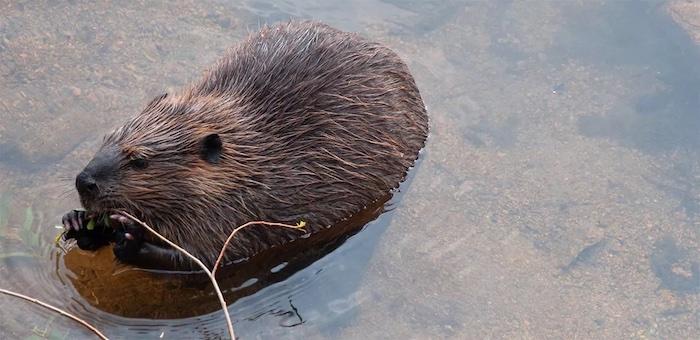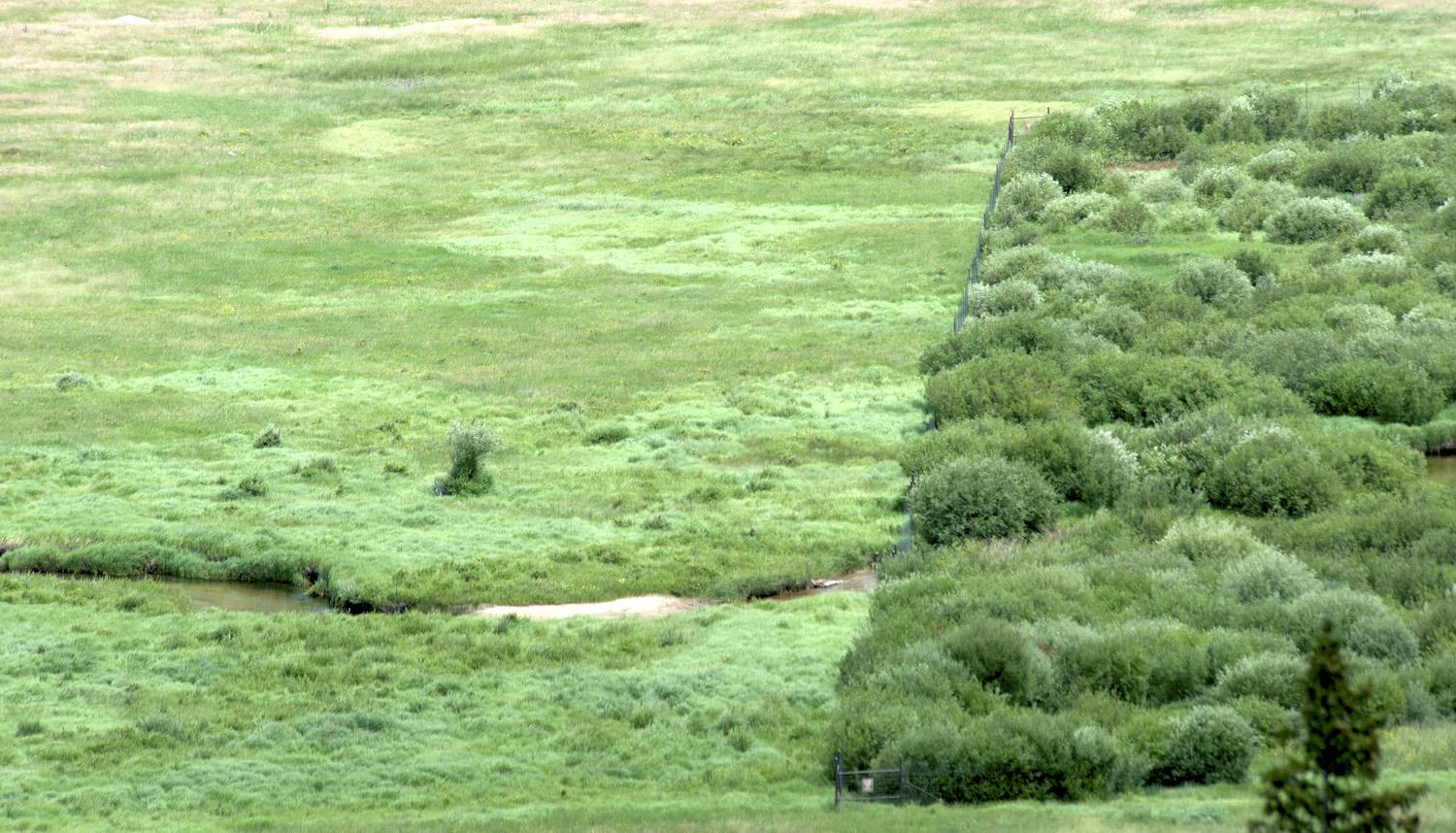Editor's note: The National Parks Traveler is producing a series of stories on the role of beavers in helping national parks restore ecosystems. This article focuses on their impact at Rocky Mountain National Park in Colorado.
The gate on the ten-foot-tall fence opened easily, and inside the wire exclosure was a tall willow forest. Beyond the wall of leaves and branches were the sounds of rushing water, backed up by a complex of beaver dams, cascading down, hidden beneath the brush. The beavers were back. But also hidden in the thicket was a large, mature bull moose, who had jumped the tall fence in a single bound. Here in Horseshoe Park, he was content and munching happily on the willows, oblivious to the large rodents.
Centuries ago, nearly every stream in today’s Rocky Mountain National Park (and America) was home to Castor canadensis, the North American beaver. “If you go back thousands of years, this valley was a giant willow stand that supported lots of different animals,” said Professor David J. Cooper from the Warner College of Natural Resources at Colorado State University during a tour of beaver habitat on the western side of the park, in the Kawuneeche Valley. “They include beavers, amphibians and all kinds of animals. When I was here 30 years ago, there were beaver dams and active beavers here, and tall willows.”

If provided a chance, and if there food sources are protected from ungulates, beavers can flourish/NPS file
But eventually, grazing, trapping, ranching, logging, and farming outside the park destroyed their habitat, while elk and moose inside the park devoured the willows and other woody vegetation beavers rely on, contributing to their downfall.
Despite their gangly presence inside and out of the park, moose are not native to Colorado. They were introduced from Yellowstone National Park by the state in 1978, and it didn’t take them long to move into the national park. But they, along with elk, in places have turned once-lush wetlands into somewhat of a savannah landscape, with close cropped grass beneath aspen groves.
“When the beavers disappear, and the hydrologic effects of the beaver go away, the landscape dries up from this wet area with willows to grasses," noted Cooper. "Most of these grasses were introduced by hay crops, so this area is becoming a dry meadow.”
And indeed, the valleys look more like pastures now.
Hanem Aboulezz, until recently the landscape ecologist at Rocky Mountain National Park, is well familiar with the faunal history of the mountainous park in northern Colorado.
“In 1913 elk were reintroduced into the park, but the predators were not reintroduced," she said. "Nothing with teeth and claws.”
Which put things out of balance from an ecological perspective.
“It’s hard for beaver to make a living competing with a large herbivore for willows,” she added.

Exclosures such as this one, and the one in the top photo, keep moose and elk from browsing willows and aspen to the ground, and allow beavers to build watery oases with their dams/Patrick Cone photos
Moose vs. Beaver
Over the top of Trail Ridge Road to the western side of the park lie the headwaters of the Colorado River, where it begins its 1,450-mile journey from the mountains to the ocean. In places it’s barely a dozen yards wide, a small, placid stream unrecognizeable from the rapid-strewn river that leaps and plunges through Canyonlands and Grand Canyon national parks. Here in the Kawuneeche Valley, moose and elk have found a vegetative bounty comprised of willows, aspen, and grasses. There are estimated to be 100-200 moose in the drainage, if not more, each eating about 50 pounds of dry forage a day.
“In the summer, 90 percent of their diet is willow,” Cooper explained as he led National Parks Traveler editors across one of the grassy meadows.

Inside an exclosure in Horseshoe Park on the eastern side of the park, willows and other vegetation grow high and lush/Patrick Cone
Crossing the meadow, Cooper walks through a ghost forest of bleached, broken willow branches, denuded over the past two decades by moose and elk. There are also the low-humped remnants of beaver dams and ponds along the way.
“In Rocky Mountain National Park, tall willow area declined by 96 percent since 1999,” said Cooper, who has personally documented the changes. “And because of the loss of beaver, open water habitat has declined by 94 percent based on air photo analysis.”
To counter this, the National Park Service embarked on a program a dozen years ago to recreate habitat for beaver, protecting and nurturing willows by building a few dozen of these fenced areas – called exclosures, as they’re designed to keep ungulates out -- covering more than 250 acres. And sure enough, by keeping ungulates from browsing on willows, the vegetation, and the indigenous beavers, have come back. “They don’t need a gigantic area of willows,” said Cooper. “Four acres of tall willow stands is enough to maintain a beaver population indefinitely.”
Inside the fenced areas in Kawuneechee Valley, the beavers do what beavers do: build dams, create ponds, flood meadows, and hold back precious water. By giving them a food source and a place to live, wildlife biologists hope to restore the landscape to what it once was. From just one big, main stem dam across a river, there might be another 20 or 30 dams supported by the slowly expanding floodplain of water.
Speaking to the success of the three exclosures in the Kawuneeche Valley, Cooper said, “When these were built, the idea was to keep them in place for 20 years, and then take them out. But people now realize that if you take them out, (the beavers) will go back to zero again.”
Watery Oases
But beavers and their dams are not immune to natural forces. Forest fires can introduce mud and sediments into the streams, as happened two years ago during the East Troublesome and Cameron Peak fires, which scorched ten percent of the park. Flooding last spring along the Colorado River tore out dams, leaving broken twigs and logs scattered across the muddy sediments.
“Last summer the beavers were blown out with the snowmelt,” said Koren Nydick, the chief of resource stewardship for the national park who accompanied us into the exclosure in the Kawuneeche Valley. “We hope they’ll build again late fall.”

Stick-built beaver lodges serve as both home insulated against winter's cold and eatable larder/NPS file
But nature will heal itself, given time, and beavers can hasten that healing with their dams that not only hold back water, but create sound footing for vegetation and quench the thirst of flora and fauna. Left to themselves, beavers can repair deep gullies cut by overgrazing, flood meadows to encourage willow growth, and provide habitats to dozens of other species. Their ponds not only hold back the spring snowmelt during an era of drought and climate change, but also act as firebreaks and, in general, repair an ecosystem back to its original state.
“Even during drought, the landscape keeps wet. [Beaver ponds] help contain wildfires, which is natural, you end up with these green islands," Nydick said. "There are a lot of benefits to this restoration.”
Aboulezz agrees that things are going the right direction. “Slowly beavers are moving back into those fenced areas. Within these wetlands the birds are amazing and the fishing is phenomenal,” she said.
And, as a changing climate intensifies the Western drought, rivers dry up, reservoirs shrink, and water managers are planning for the worst. But upstream in these mountains, along the Colorado River, a handful of organizations are planning for the future and taking action to restore a riparian landscape, and beavers are taking a starring role. The Kawuneeche Valley Ecosystem Restoration Collaborative is finding ways to work together with representatives from the National Park Service and U.S. Forest Service, Grand County, (Colorado), the Town of Grand Lake, The Nature Conservancy, the Colorado River Water Conservation District, and Northern Water, a nonprofit.
KVERC is finding ways to rebuild wetlands, increase water storage, reduce erosion, support local agriculture and industry, and even help with fire protection. During the past two years, these groups realized that by working together they might be able to recreate a healthy and resilient watershed, which is important to everyone.
KVERC writes, “Without tall willows as food and building material, beavers are now uncommon, and their dams no longer encourage the overbank flooding along streams, which is needed to maintain wet meadows and healthy, diverse ecosystem.” This might entail building simulated beaver structures (also called beaver dam analogs) to create the right conditions for the animals to settle. A healthy watershed is essential for humans, animals, birds and the landscape itself, especially in these times of a changing climate. And a healthy beaver population ensures a healthy, natural environment."






 Support Essential Coverage of Essential Places
Support Essential Coverage of Essential Places







Comments
More prgress!
Excellent article. Very enlightening.